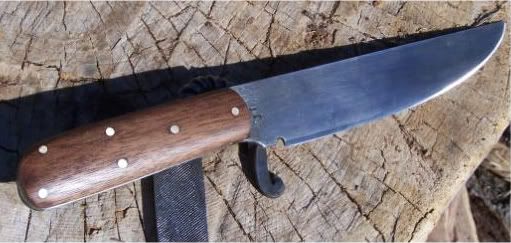When I first tried to drill a Laminated steel tang, I was all concerned about ruining the temper of the blade. So, I rigged up a can of water to put the blade in, holding the blade in vise grips, and the vise grips in my bench vise-- a regular Rube Goldberg contraption! :shocked2: :blah: :rotf: I needed to first find out if my cheap, Propane torch would heat the tang metal Hot enough to "touch" with a drill bit!
Well, In maneuvering the vise grips in the can of water, I happened to touch the blade just above the water, and below the jaws of the vise grips.
COLD! Not even warm. Now, I flipped some droplets of water off my finger onto the tang, above the jaws, and below where I had heated the tang, and sure enough, the drops sizzled off in no time at all. So, with wet finger tips. I removed the can and just felt the blade below the jaws of my small vise grips. Cold. The Vise Grip jaws were warm, but not hot.
I put the can of water aside, put the blade into my bench vise jaws, and removed the vise grips from the tang. Holding the blade from the bottom, I adjusted the blade's position in the jaws of the BENCH VISE so that the jaws were closer to the point where I wanted to drill, and locked up the jaws. I then heated the tang red/orange hot, put the torch down, grabbed my electric hand drill, put some oil in the bit, and drilled the hole.
The curls of steel that came off the flutes of the standard high carbon drill bit, looked like the curls you expect to get drilling holes in soft pine! That drill cut through the tang so fast, I almost lost my balance!
For those of you have never tried to drill tough, hardened steel at room temperature, my drill bit would not even cut a starting hole with me pushing the hand drill with all my strength and weight. I pushed so hard, that my workbench, which had a load of bricks on the bottom shelf to help stabilize it, lifted off the floor. NOTHING
! I think I made a bigger dent with my hardened Center punch, than anything my drill bit did. In fact, the bill dulled, and I went to the hardware store the next day to replace it. I actually bought 3 bits that next day, including an expensive carbide point bit. I didn't use it, and returned it for a refund the following day.
The idea of using heat to soften the tough steel came to me on my way home with my "new " drillbits.
I remembered watching a wheelwright put a steel "tire" on a wooden wagon wheel, heating the 1/4" thick steel "tire" up and then using a punch "hardie" on his anvil, and a sledge hammer, with the aid of a helper holding the tire up, to punch out holes in the two ends of the tire so he could rivet them together. One Good "Whack" with the hammer on each side of the tire, for each hole( two each) was all it took to knock out a 1/4" diameter hole in both ends of the "tire". Even if you use a high speed drill press, its going to take you longer to drill 4 holes in that thick steel, than it took for that wheelwright to punch those holes doing it his way.
Members might want to keep this in mind for working with steel with other tools, too. If you have no other choice but to use a hacksaw to cut out a piece from steel stock, for instance, you might do well to heat up the metal that is to be cut, and then cut it with the saw, stopping every couple of strokes, to cool down the blade in water before proceeding again. Wear gloves, and don't burn yourself. Hot steel will cut very fast, so as inconvenient at it first sound to think of having to stop every couple of strokes, to cool the blade, You will expend less energy, and make your cuts faster. :hmm:







